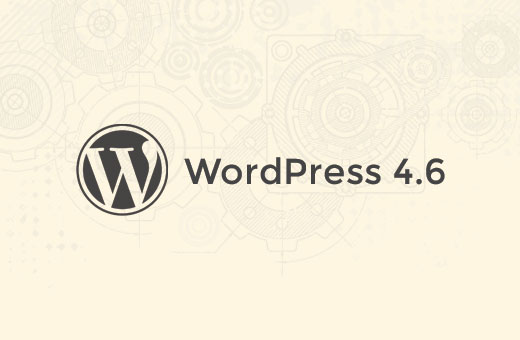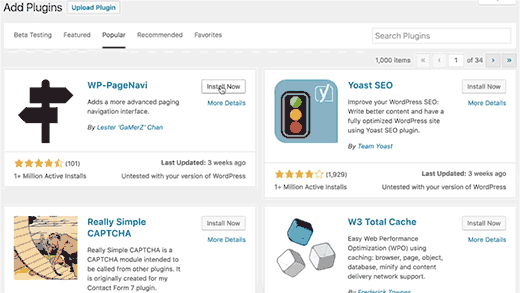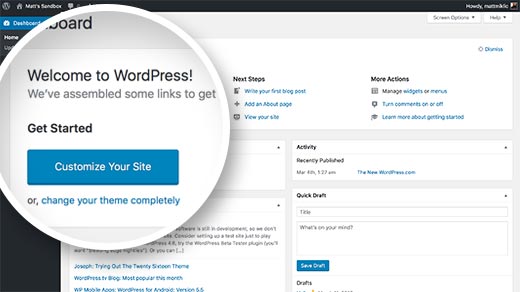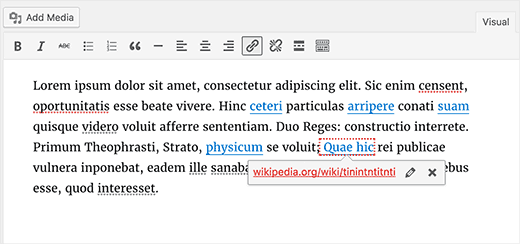Se ha lanzado la versión beta de WordPress 4.6. Seguimos de cerca el desarrollo y nos complace informar que se espera que la versión final se lance alrededor del 16 de agosto de 2016. En este artículo, destacaremos lo que viene en WordPress 4.6 con características y capturas de pantalla.

Nota: Puedes probar la versión beta en tu computadora o en un entorno de staging usando el plugin WordPress Beta Tester.
Esta es la versión beta, lo que significa que no se agregarán más funciones nuevas hasta el lanzamiento final de WordPress 4.6. Sin embargo, algunas de las funciones en beta podrían no llegar a la versión final.
Actualizaciones brillantes en WordPress 4.6
Cuando los usuarios instalaban un nuevo plugin o tema, o actualizaban uno, solían ver una pantalla de progreso. Esta pantalla de progreso agregaba una carga de página más y era un poco distractora.
WordPress 4.6 introducirá actualizaciones brillantes. Los usuarios ahora podrán actualizar e instalar plugins y temas sin ser redirigidos a la pantalla de progreso.

Fuentes del sistema nativas en el área de administración de WordPress
WordPress comenzó a usar la fuente Open Sans en el área de administración de WordPress para ofrecer una apariencia consistente en diferentes dispositivos y plataformas. Sin embargo, esto significaba que WordPress dependía de una fuente externa de terceros. Esto también aumentó los tiempos de carga de la página del área de administración y afectó la velocidad.
Con WordPress 4.6, el área de administración volverá a usar las fuentes del sistema. Esto significa que su área de administración de WordPress puede verse ligeramente diferente en diferentes plataformas.
Aquí tienes una captura de pantalla del área de administración en el navegador web Safari en macOS usando la fuente del sistema San Francisco.

Estas son las fuentes del sistema que se utilizarán en el área de administración de WordPress en diferentes plataformas y entornos.
- apple-system para Safari y Firefox en macOS e iOS
- Helvetica Neue en macOS anterior a 10.11
- BlinkMacSystemFont para Google Chrome en macOS
- Segoe UI para Windows
- Roboto para Android y Chrome OS
- Oxygen-Sans para KDE
- Ubuntu para Ubuntu
- Cantarell para GNOME
- sans-serif, el respaldo estándar
Nota: Este cambio solo afecta a los elementos de la interfaz de usuario del área de administración de WordPress. No afectará a las áreas de contenido como el editor de publicaciones, que utiliza la hoja de estilos del editor de tu tema para las fuentes.
Mejoras en el editor en 4.6
La mayoría de los usuarios de WordPress pasan más tiempo en el editor de publicaciones que en cualquier otra pantalla de administración de su sitio. Mejorar la experiencia de edición de publicaciones siempre tiene prioridad en las nuevas versiones de WordPress.
Función de autoguardado mejorada
WordPress 4.6 trae mejoras a la función de autoguardado en WordPress. Anteriormente, cuando los usuarios deshabilitaban las revisiones, esto también afectaba la restauración de publicaciones desde la función de autoguardado.
WordPress 4.6 solucionará este problema y los usuarios podrán restaurar las publicaciones de WordPress a partir de copias de seguridad del navegador y autoguardado, incluso cuando tengan las revisiones deshabilitadas.
Resaltado de enlaces rotos
Si estás utilizando el editor visual para escribir publicaciones, entonces se resaltará la URL rota que agregues.
Tan pronto como agregues un enlace, WordPress verificará si el enlace es válido. Si colocas el cursor sobre el texto enlazado, verás el enlace en color rojo en lugar del azul habitual.

Mejoras internas
Estas actualizaciones mejoran partes significativas del núcleo de WordPress, pero están destinadas principalmente a los desarrolladores.
Registro Estandarizado de Metadatos
WordPress 4.6 trae la función register_meta() para el registro de claves meta. Esta función funciona de manera similar a la función register_post_type(). Permite a los desarrolladores de plugins y temas utilizar una forma estandarizada para trabajar con datos meta almacenados con objetos de publicaciones, usuarios, comentarios o términos. (#35658)
Nueva Clase WP_Post_Type
WordPress 4.6 introducirá la nueva clase WP_Post_Type. Cambia $wp_post_types a un arreglo de objetos WP_Post_Type. Esto proporciona métodos para manejar soportes de tipos de publicación, reglas de reescritura, cajas meta, ganchos y taxonomías. (#36217)
Nueva Clase WP_Term_Query
Similar a las clases WP_Query, WP_User_Query y WP_Comment_Query, WP_Term_Query en WordPress 4.6 proporcionará una mejor estructura para generar consultas de términos. (#35381)
Clases WP_Site_Query y WP_Network_Query
Para redes de WordPress multisitio, las nuevas clases WP_Site_Query y WP_Network_Query permiten consultar sitios y redes con carga diferida. (#35791, #32504)
Esperamos que este artículo te haya ayudado a conocer lo que viene en WordPress 4.6. ¿Haznos saber qué características te parecen emocionantes y qué te gustaría ver en futuras versiones de WordPress?
Si te gustó este artículo, suscríbete a nuestro Canal de YouTube para tutoriales de video de WordPress. También puedes encontrarnos en Twitter y Facebook.





Nico
Wordpress debería tener una herramienta como GoogleDev Tools (Source Render) para codificar Front-End sin tantos plugins involucrados y toda la pesadilla.
¡Por favor, libertad para los desarrolladores front-end!
¿Por qué tengo que usar un editor como el Family Game o Sega?
Quiero decir, Wordpress debería agregar una especie de GoogleDev Tools para trabajar y actualizar HTML, CSS y JS.
Y que los plugins sean para quienes no quieran codificar. Pero al menos piensen en los desarrolladores si tienen un entorno Woocommerce, y tantas cosas para trabajar, piensen en grande, Wordpress.
Si tienes Woocommerce, deja el estilo de software basado en plugins de blog y crea un lado completo para desarrolladores de front-end.
Además, no me interesa programar funciones PHP de back-end. Wordpress es una gran solución de back-end.
¿O escribo esto para nada y ya existe una herramienta para lo que digo y me he vuelto loco con esta tierra de pesadilla de plugins?
¿Alguien puede ayudar???
Saludos cordiales
kris
Me encantaría que wordpress recordara la categoría de la última publicación, al crear una nueva, ya estaría seleccionada... en lugar del 'acerca de' predeterminado
un gran ahorro de tiempo en mi opinión
Soporte de WPBeginner
WordPress usa la categoría predeterminada como la categoría preasignada para las nuevas publicaciones.
Administrador
kris
thanks! right you are. after 6 years of using wordpress. I learn something so basic
aunque mi sugerencia sigue siendo válida,
Grant Winney
Es genial ver que todavía se están haciendo mejoras y que alguien está prestando atención al tiempo de respuesta.
El validador de enlaces me parece extraño. Casi cada vez que he pegado un enlace en una publicación, lo he copiado de otra pestaña donde tengo la página abierta. No recuerdo una vez que haya tenido un enlace guardado en un archivo de texto o algo así, y el sitio hubiera muerto entre que copié el enlace y lo referencié en una publicación.
Sandeep Mohanty
Thanks for the list of WordPress 4.6 Very Good.
Brian
Todavía esperando los filtros de búsqueda de plugins. Filtrar por campos disponibles actualmente para compatibilidad, instalaciones activas y última actualización sería una gran mejora.
Osman
¡¡¡Sí, se agregarán filtros de búsqueda de plugins!!!
Manjunath Naik
Gracias por la información útil.
Dan Heath
Sigo deseando que las páginas muestren categorías específicas de publicaciones, y solo esas categorías. Creo una página sobre la construcción de un toldo. Solo quiero que aparezcan en esa página las publicaciones de las categorías que especifico, como "Toldo". Si no especifico ninguna categoría para esa página, entonces muestra todas las publicaciones.
Lo que hay en esta versión está bien, pero no es realmente relevante para mis necesidades. Lo que pedí aquí, lo he pedido muchas veces. Si pudiera escribir un plugin para ello, lo haría. Si alguien conoce un plugin que haga esto, me gustaría mucho saberlo.
Shaun Nestor
Hola Dan,
Para que una página muestre solo publicaciones de una categoría determinada, es bastante simple, solo dirija a sus usuarios a la URL /category/
Por ejemplo, si su sitio web está en http://www.example.com y sus publicaciones de toldo están todas en la categoría 'Toldo', puede enviar a los usuarios a http://www.example.com/category/canopy/
Espero que esto aborde la frustración que has estado experimentando.
-Shaun
Dylan MacDonald
Esto ya no me funciona en Wordpress 4.6. Todas mis páginas de categorías ahora están en blanco. ¿Es este un problema conocido?
Sufyan Shaikh
muchas gracias por dar una idea de lo que habrá en Wordpress 4.6.
Arta
El verificador de enlaces del editor es increíble.
Triet Minh
¡Actualización interesante! vale la pena la espera.
ibrar
buena información hermano, algo bueno de wordpress
Loi Tran
Gracias por la publicación informativa y bien elaborada.
Temitayo Boboye
¡¡¡Wow!!! esto es genial, me encanta la actualización del plugin y WP_Post_Type. No puedo esperar a ver esto en acción. Voy a la beta ahora #GoingForBeta
John Brian Shannon
"Cuando los usuarios instalaban un nuevo plugin o tema, o actualizaban uno, usualmente veían una pantalla de progreso. Esta pantalla de progreso añadía una carga de página más y era un poco distractora."
¡Felicitaciones a WordPress! Esto es una gran molestia para muchas personas, especialmente si viajan por un área con internet lento.
Y todas esas cargas de página de progreso combinadas —de todas las fuentes 24/7 en todo internet— actúan para ralentizar toda la red, añadiendo millones de operaciones de este tipo por día. Es escandalosamente derrochador y consume tiempo en su totalidad en internet.
Espero que pronto, no solo los hosts de sitios web como WordPress, sino todos los sitios en la web sigan el liderazgo de WP en esto.
Gracias por publicar este artículo. Bien hecho.
Saludos, JBS
Kosta
Hm, nada especial en este parche
Emily
Si tienes alguna influencia, una mejora muy buena y muy básica sería tener un cuadro de diálogo de "¿Estás seguro?" después de presionar el botón Publicar. Es asombroso que esto no haya sido parte de WordPress desde la primera versión.
Lin
Emily, hay un plugin que encontré hace poco después de presionar Publicar en lugar de Guardar Borrador. El que encontré y estoy usando se llama "Publish Confirm". ¡Me salvó la vida! Y sí, debería estar en WordPress básico.
Davide De Maestri
Thank you for this quick list of WordPress 4.6 news!